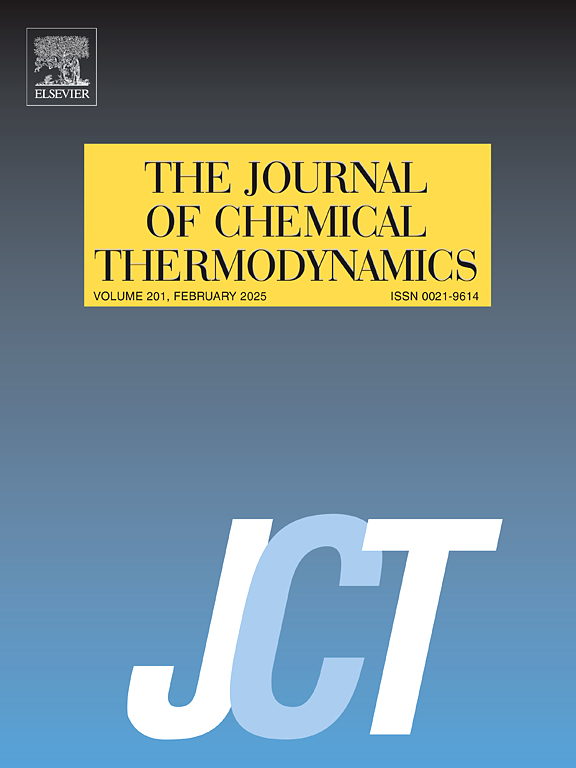PET瓶催化与非催化热解及微碳棒形成的热重动力学研究
IF 2.2
3区 工程技术
Q3 CHEMISTRY, PHYSICAL
引用次数: 0
摘要
本研究使用二茂铁(F)、赤泥(RM)、镍/铜/钼多组分催化剂(kieselguhr)和二茂铁-赤泥混合物等催化剂,在有或没有过氧化氢的情况下,研究了聚对苯二甲酸乙二醇酯(PET)瓶的热重热解行为。加热速率分别为10、20和30°C/min。采用Kissinger-Akahira-Sunose (KAS)和Flynn-Wall-Ozawa (FWO)模型测定的活化能(Ea)低于纯PET (189 kJ/mol)。过氧化氢的Ea最低(53 kJ/mol),热解完全,无焦。扫描电镜分析结果表明,炭中存在微碳棒(MCR)。可根据最终产物的需要选择最佳催化剂。例如,如果目标是创造MCR,二茂铁和赤泥可能是最佳选择;如果目标是充分热解,H2O2可能提供最大的结果。热力学分析(ΔH, ΔG和ΔS)表明,含催化剂PET的焓值低于纯PET。这表明催化热解的协同作用可能降低了PET热分解过程中形成活化配合物所需的能量。本文章由计算机程序翻译,如有差异,请以英文原文为准。
Thermogravimetric kinetic study of catalytic and non-catalytic pyrolysis of PET bottles and micro carbon rod formation
This study examined the thermogravimetric pyrolysis behaviour of Polyethylene Terephthalate (PET) bottles using catalysts like ferrocene (F), red mud (RM), a Ni/Cu/Mo multicomponent catalyst on kieselguhr, and ferrocene-red mud mixtures, with or without hydrogen peroxide. Heating rates of 10, 20, and 30 °C/min were used. The Kissinger–Akahira–Sunose (KAS) and Flynn–Wall–Ozawa (FWO) models determined activation energies (Ea), which were lower with catalysts compared to pure PET (189 kJ/mol). The lowest Ea (53 kJ/mol) was achieved with hydrogen peroxide, resulting in complete pyrolysis and no char. SEM analysis of the resulting char showed micro carbon rod (MCR) formations. The best catalyst can be chosen based on the needs of the final product. For example, if MCR creation is the goal, ferrocene and red mud may be the best choice; if full pyrolysis is the goal, H2O2 may provide the greatest result. The thermodynamic analysis, including ΔH, ΔG, and ΔS, indicated that the enthalpy values for catalyst-containing PETs are lower than those for pure PET. This suggests that the synergistic effect of catalytic pyrolysis likely reduces the energy required to form the activated complex during the thermal decomposition of PET.
求助全文
通过发布文献求助,成功后即可免费获取论文全文。
去求助
来源期刊

Journal of Chemical Thermodynamics
工程技术-热力学
CiteScore
5.60
自引率
15.40%
发文量
199
审稿时长
79 days
期刊介绍:
The Journal of Chemical Thermodynamics exists primarily for dissemination of significant new knowledge in experimental equilibrium thermodynamics and transport properties of chemical systems. The defining attributes of The Journal are the quality and relevance of the papers published.
The Journal publishes work relating to gases, liquids, solids, polymers, mixtures, solutions and interfaces. Studies on systems with variability, such as biological or bio-based materials, gas hydrates, among others, will also be considered provided these are well characterized and reproducible where possible. Experimental methods should be described in sufficient detail to allow critical assessment of the accuracy claimed.
Authors are encouraged to provide physical or chemical interpretations of the results. Articles can contain modelling sections providing representations of data or molecular insights into the properties or transformations studied. Theoretical papers on chemical thermodynamics using molecular theory or modelling are also considered.
The Journal welcomes review articles in the field of chemical thermodynamics but prospective authors should first consult one of the Editors concerning the suitability of the proposed review.
Contributions of a routine nature or reporting on uncharacterised materials are not accepted.
 求助内容:
求助内容: 应助结果提醒方式:
应助结果提醒方式:


